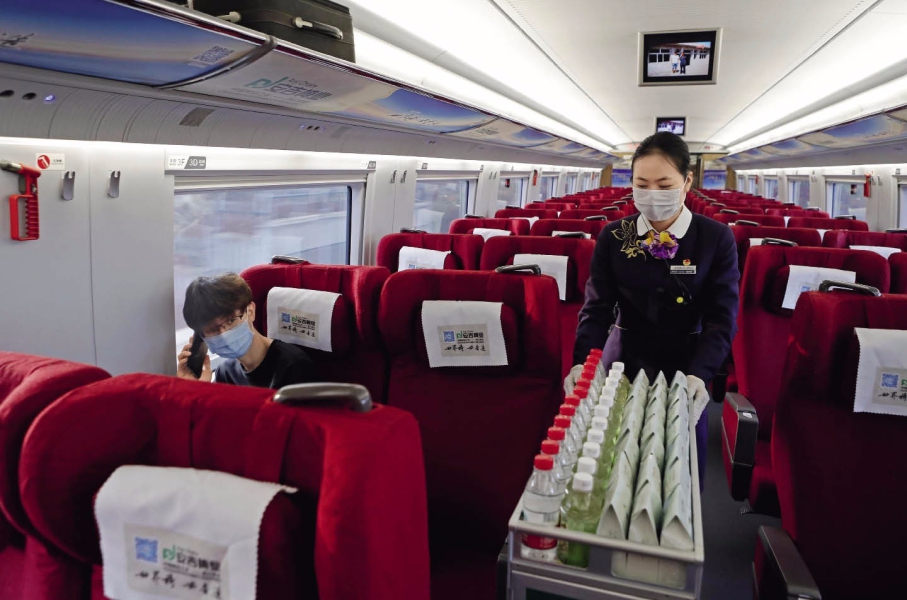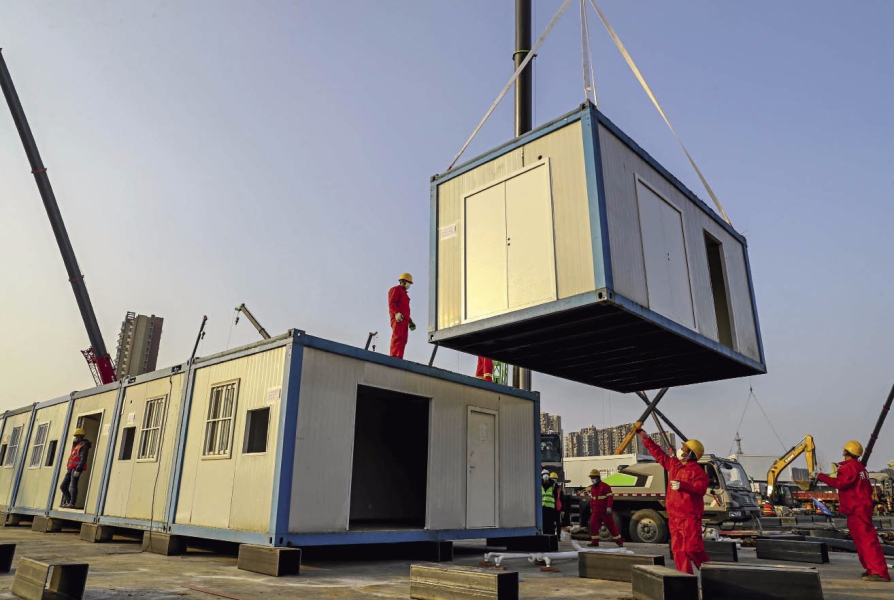“Patients were waiting for us, and there would be more hope the sooner the hospital was completed.”
Various construction projects are progressing at full speed at the construction site of Wuhan Huoshenshan Hospital in late January.
Hospital Builders
As more and more coronavirus cases were confirmed in Wuhan, local medical facilities soon became unable to meet the mounting needs of patients. Many suspected patients could not be admitted to hospitals and could only isolate themselves at home. Diagnosis of some patient’s condition has therefore been delayed, increasing the danger of further spreading of the disease.
As a result, the Wuhan municipal government decided to build Huoshenshan Hospital and Leishenshan Hospital. Within about 10 days, the two temporary hospitals were erected and put into use on February 3 and 5 respectively.
On Chinese New Year’s Eve, the construction site of Huoshenshan Hospital was brightly lit, and various machines were running at full capacity. The China Construction Third Engineering Bureau organized hundreds of construction units to participate in the project.
Meng Dongbing and Mei Jun were among numerous builders involved. The couple originally planned to return to their hometown in Shandong Province to celebrate the Chinese New Year, but at noon on January 24, they learned that the bureau would be responsible for the construction of the Huoshenshan Hospital. They immediately refunded their tickets and rushed to the construction site without hesitation. Meng had just undergone a minimally invasive surgery on his lungs, and his colleagues advised him to take a rest.
Meng replied, “I knew I could do it. Patients were waiting for us, and there would be more hope the sooner the hospital was completed.”
Mei was engaged in the intensive work of logistics preparation and vehicle dispatching, which was made more difficult because of the holiday. The couple often worked until midnight at the construction site.
Meanwhile, Zhou Mi, an employee of the bureau, was responsible for material procurement and logistics at the project site. As a native of Wuhan, he went to work on the night of January 23 once he was notified. “We had to prepare the materials needed for the on-site office as fast as possible,” said Zhou. Medicine, umbrellas, thermos flasks — the variety of materials needed was so huge that his father had to drive him around to every supermarket and shopping mall in Caidian District of Wuhan to make his purchases. At the time, Zhou’s mother, who works in a fever clinic at the Wuhan No.7 Hospital, did not return home for four days as she was busy treating patients. The family of three did not even get together on Chinese New Year’s Eve, and could only communicate on WeChat (China’s twitter-like messaging platform). “Knowing that we were all fighting together, I feel at ease,” said Zhou.
Jiang Guixi, the project leader of the third construction company of the Bureau, who has not returned home for the Chinese New Year for 19 years, was recalled and returned to Wuhan as soon as he arrived at his hometown this year. There were more than 4,000 workers at the construction site. Having to complete the daily task of arranging three meals a day, taking the temperatures of incoming and outgoing personnel, and arranging and managing security personnel, all meant that Jiang was overloaded throughout the holiday. He said he had served in the army for 14 years and now saw this virus as an enemy which had to be defeated.
From a wasteland to a standard hospital for infectious diseases, it took only 10 days for these frontline dedicated workers working under harsh conditions, day and night to complete the miracle facilities.
High-speed Train Conductors
As the epidemic outbreak took place during the holiday when China’s greatest people migration takes place, the movement of people undoubtedly increased the difficulty and risk of failing to control the epidemic. As a result, high-speed train conductors have become high-risk occupations.
“For others, maybe not going out is being responsible to yourself and others. As a Party member and chief conductor, leading the team members to brave the adversity at this time is our real mission,” said Peng Mingjing.
As a mother of two children, this year is her 17th Spring Festival travel season on the job. When the news of the outbreak broke, the family hoped that she would be able to take time off to be with her two children and elderly parents, but she was not able to do that.
Her parents understood her choice, but it was tough on her two young children. The oldest girl, a fifth grader of an elementary school, saw news of the epidemic on TV and social media. She was especially worried that her mother would take the train also transporting people infected by the virus. On one occasion when Peng was leaving home, she saw her two daughters in pajamas tearfully blocking the door so she could not leave. After Peng eventually left, she cried her heart out. “It was the first time I have ever left home in tears,” she said.
Things at home can be easily settled. Peng knows that the more important responsibility lies in taking care of her colleagues and passengers. She makes sure that while on duty she is always smiling, giving passengers a sense of reassurance. While explaining the epidemic prevention methods to other crew members, she also reminds passengers to wear masks, wash their hands frequently, and maintain environmental hygiene.
“In the face of the epidemic, we are committed to transporting passengers safely and in an orderly fashion. It is my duty as a Party member and chief conductor. We will eventually beat this epidemic,” said Peng.







